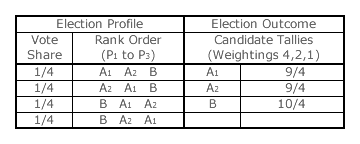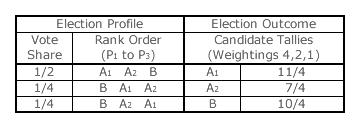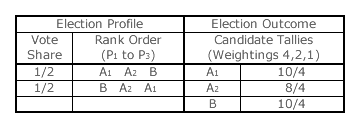Evaluations: Clones, Teaming and Independence Criteria 6
CHPV, Clones and Teaming
Before evaluating the vulnerability of GV to teaming, it is easier and more relevant to address CHPV in particular first. Consider again two candidates A and B fighting over a single vacancy in a CHPV election. If half of all voters prefer A and the other half prefer B, then a critical tie results. If one voter is added or removed, then this tie would be broken in favour of one of the candidates. The party to which A belongs may be tempted to substitute two clones A1 and A2 in place of A in the hope of gaining unfair advantage over B.



The table opposite shows the outcome of these strategic nominations by party A. As none of the voters were guided as to how to rank the A clones, then both A and B first preference supporters were as likely to rank A1 ahead of A2 as the other way round. By default, identical rather than fraternal cloning is produced here. As identical clones split the vote, this self-harm breaks the tie and grants victory to their opponent B. In order to gain the advantage it seeks, party A must instruct its supporters to rank the A clones according to its own forward slate of approved candidates. Here, A1 is the superior fraternal clone and A2 is the inferior one.
If A supporters are all loyal to party A then the table opposite gives the outcome. Now, these fraternal clones have succeeded in teaming and getting A1 elected. The voters have not changed their equally split preferences for A or for B yet the teaming by A has unfairly given it victory. How should party B respond? It could copy A and add a clone of its own to nullify the cloning by A and hence maintain the critical tie. Or it could add yet another clone to beat A. A could add more clones to fight back. Then B could add more and so on. Is there an alternative to this runaway cloning?
Yes, party B should retaliate not by adding any clones but by reversing the slate issued by A and asking its own supporters to rank A2 ahead of A1 on their ranked ballots. If all such supporters are loyal, then the table opposite shows the outcome. This tit-for-tat retaliation has successfully thwarted the teaming attempt by A and has even restored the original critical tie between party A and B.
It is no co-incidence that the tie is re-established. Party A introduced the inferior fraternal clone A2 not to compete for the vacancy but just to push B down the rankings and bury the chances of B winning. A supporters duly lowered their ranking of B from second to third preference. However, A2 was of equal use to the B supporters who duly lowered their ranking of A1 from second to third place. Any two-way tie is rigorously maintained when both parties adopt mirror-image nomination strategies; one slate being the reverse of the other.
Proceed to next page > Evaluations: Clones & Teaming 7
Return to previous page > Evaluations: Clones & Teaming 5
